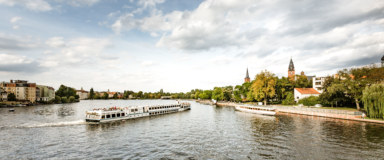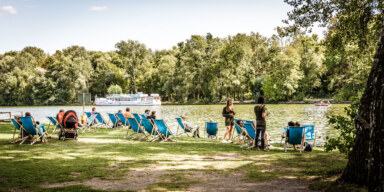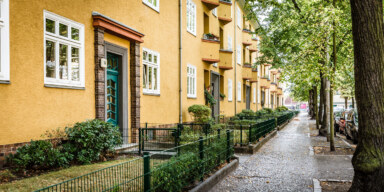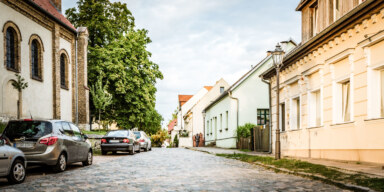Treptow
The spacious one
Treptow is the greatest, and also the largest on the map of Berlin. And it is the greenest of them all, and the one with the most water. Over half of its area is covered by woodlands, lakes and rivers. It is the ideal place to work, live, and rest. Amid its abundant nature, the district hosts Europe’s most modern technology park, but also offers a whole alphabet’s worth of leisure options, from A for angling to Z for zumba.
All those who do not necessarily want to live in the city will be pleased to see that Treptow’s rents are (still) moderate. Living on the outskirts leaves you plenty of space: flats in pre-fabricated high-rises, rehabilitated former GDR stock, single-family homes and listed terrace houses. Disused industrial sites are being re-discovered by artists, former factories now accommodate co-working spaces for start-up companies. A new spirit emerges. Everything is possible, and coming home can help. Flats here are large enough for a family or a student flat-share.
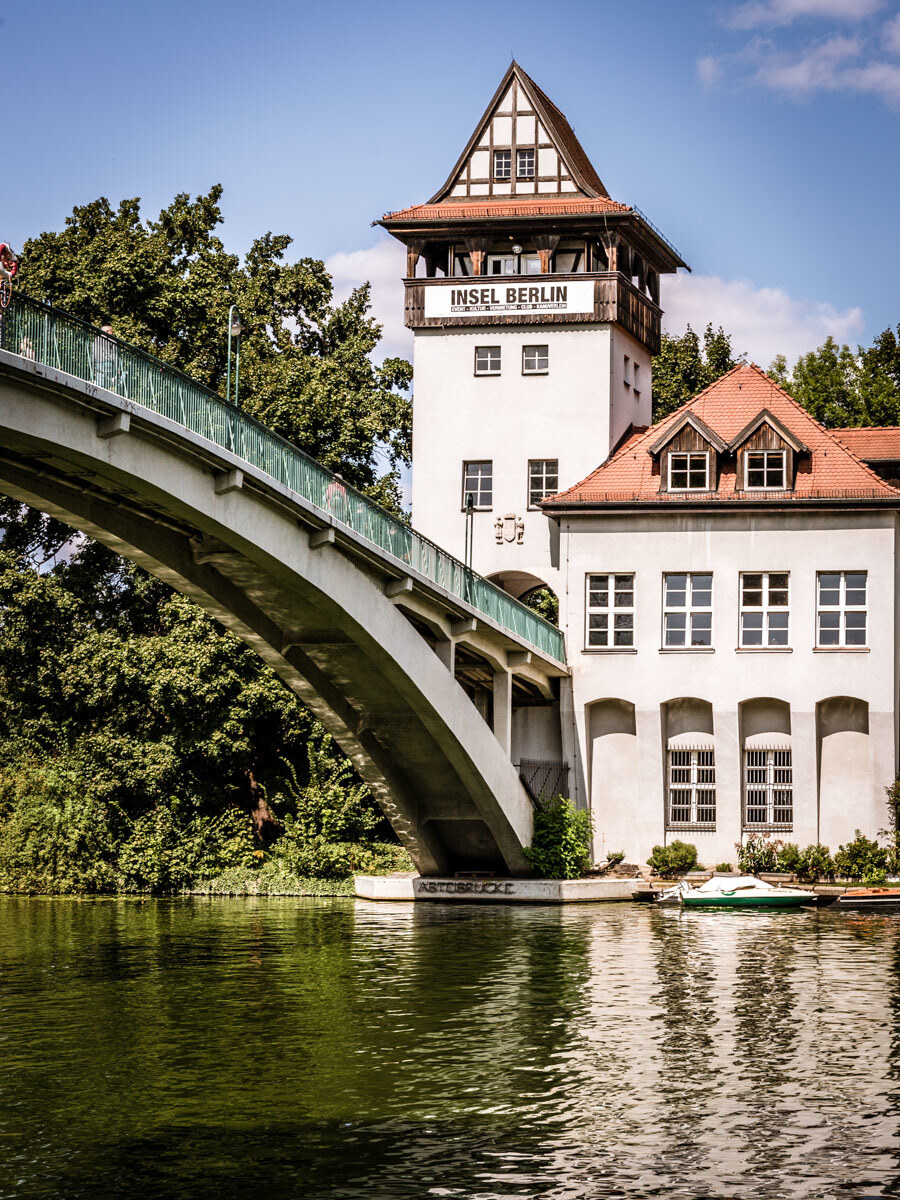
» Disused industrial sites are being re-discovered by artists, former factories now accommodate co-working spaces for start-up companies. «
Boundaries are fluid: Treptow is already a bit like Kreuzberg. Alt-Treptow with its cafés and restaurants continues seamlessly into Kreuzberg’s party zone. Electric sounds waft across: people chill out at the Club der Visionaere, an internationally renowned open air bar at the “Flutgraben”. You could spend the entire summer here, with wooden decks to sit on, amid white sails and coloured lights, with your feet dangling in the water. DJs make the air quiver, to delight the night owls …
Treptower Park is Berlin’s largest picnic green. It is a park of many superlatives, twice the size of Monte Carlo, and the most gigantic horticultural project of its time. Between 1876 and 1888, 130,000 cubic metres of earth were moved, 90,000 trees and 25,000 roses planted. Idyllically located on the River Spree, The Volkspark also attracts visitors from the neighbourhood: on a nice day, people from Kreuzberg, Neukölln and Friedrichshain come over for a day out. The 4-kilometre riverside paths are great for walking, cycling and jogging.
Lovers of cosiness will enjoy Gasthaus Zenner, established in 1822 with a beer garden and its own jetty on the River Spree. It was re-built after the war and re-opened in 1956. The traditions live on: get up and dance to live music, to work off those Sunday-lunch calories. Especially popular is the over-40s party on the first Friday of every month.
Berlin is always good for a surprise. Sitting in the middle of Treptower Park is the “Himmelskanone” (sky cannon), a record-sized telescope in Germany’s oldest and largest public observatory. Nowhere will you be so close to the heavens. The Archenhold Observatory owns the world’s longest refracting telescope with a 21 metre focal length. The place is steeped in history, as it was here that, in June 1915, Albert Einstein gave his first public lecture on the General Theory of Relativity.
Immediately next to the Stralau peninsula, a narrow bridge takes you down memory lane: Berlin is the only place that has an “Insel der Jugend” – island of youth. The name, of course, comes from GDR times. For today’s Berliners, it is ‘love island’, because with old chestnut trees and waterlilies it is simply made for kissing. In 1896 “Neuspreeland” was chosen as the site for the Great Industrial Exposition, when Berlin aimed to follow in the footsteps of Paris and London and hold a world exhibition of its own. It turned out to be a complete flop. Today, the car-free island is a refuge for those in the know. “Kanuliebe” is a firm that offers nicely overhauled, cheerfully painted boats for hire, and the Inselcafé is a good place to relax, with a sunbathing lawn, barbecues and wicker beach chairs. Bring on the fresh air!
In the midst of the noisy world, this place of silence appears almost surreal: The Soviet war memorial in Treptower Park is the largest outside Russia. Over 7000 Red Army soldiers are buried here. On a green hill, a 13-metre bronze statue sends out an appeal for peace. Called “the Liberator” it shows a young Red Army soldier carrying a small girl on his left arm and lowering a mighty sword with his right. Under his boot, a broken swastika as a symbol of victory over Nazi terror. History, cut in stone.
Besides monuments on land there are also some on the water, like the 30 metre sculpture on the surface of the River Spree: Molecule Man. A shimmering ensemble of light and shade, made of perforated aluminium sheeting. It shows three male figures leaning towards each other, marking the point where three Berlin districts meet. For the American sculptor Jonathan Borofsky, molecules symbolise change and motion. And Berlin is incredibly molecular!
» Treptower Park is Berlin’s largest picnic green. It is a park of many superlatives, twice the size of Monte Carlo, and the most gigantic horticultural project of its time. «
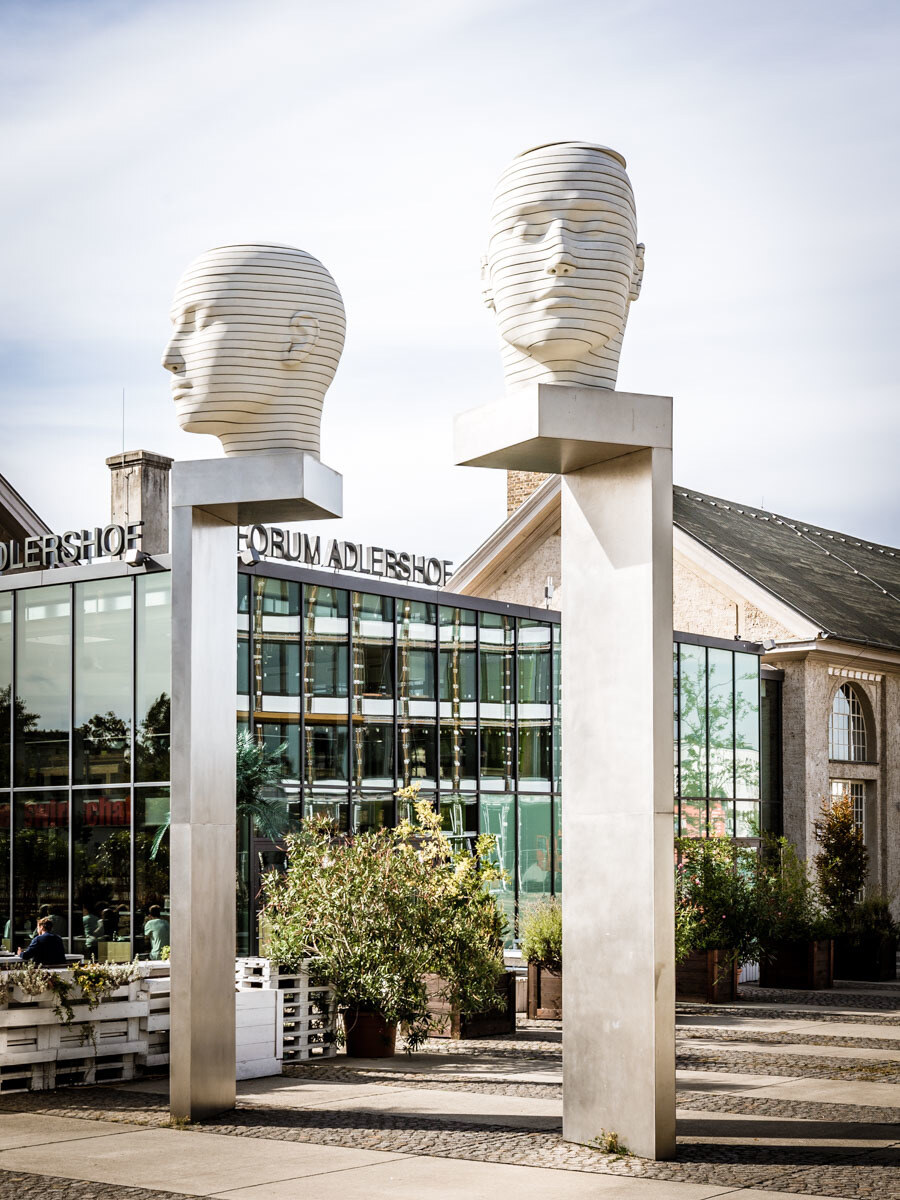
Adlershof
The clever one
Berlin is lifting off into the future, and Adlershof is a leading driver of that development. Following the fall of the wall, it became the site of a planned city, the famous WISTA, or “Wissenschafts- und Wirtschafts-Standort” – a science and business park. It is the biggest cluster of its kind in Germany. Teeming with researchers, engineers and business networks, it is home to about 1,100 firms with 18,000 people on the payroll. Here Berlin’s Humboldt University has six science institutes with over 6,000 students, and cooperates closely with companies, both established ones and start-ups. Adlershof is the smartest district in town – and one of the most affordable to live in: coming home offers a number of modern apartments that have everything needed for a good start in Berlin.
But Adlershof is also Berlin‘s biggest media park. Films have been made here since 1920, and the black and white GDR TV stations here switched to colour in 1969. In the archives are treasures like Eisenstein’s “Battleship Potemkin” and the “Olsen Gang” film series. Broadcasting live from Studio D is Anne Will’s weekly political talk show. TV debates between candidates for Chancellor happen here every four years, and now and then Tom Hanks shoots one of his melancholy comedies. It is also the home of a well-known figure with a goat’s beard and a jellybag cap: the iconic Sandman, popular also in Sweden, Japan and Egypt. It would not make a good mascot, though, for Adlershof is wide awake.
» Teeming with researchers, engineers and business networks, it is home to about 1,100 firms with 18,000 people on the payroll. «
Köpenick
The cosy one
To live where others spend their holidays. Köpenick’s claim to fame is not only its legendary Captain, but also a lake, woodlands and fields. A green zone, as more than two thirds of it is open country. A lot of space to settle into, as it has Berlin’s lowest population density. The town itself is a picture postcard: historic buildings, a baroque palace By the water, pretty family homes, but also some GDR prefab high-rises. The city avant-garde may not be here yet, but the first few Prenzl-Bergers have already arrived, along with their organic food shops, cafés and bicycles. Life is restful, with a delightful small-town flair. Lake Müggelsee is to East Berliners what Wannsee is for the West Berliners. People enjoy boat trips on weekends, cycling in the Köpenick forest, or walking through the lake-studded landscape. It has always been a great place for swimming and canoeing. Water lovers hire a canoe or a pedal boat, athletes can choose between sailing boats, paddleboarding and surfing.

» The city avant-garde may not be here yet, but the first few Prenzl-Bergers have already arrived, along with their organic food shops, cafés and bicycles. «
The urban jungle is far away but also surprisingly close. A 40 minute trip on the S-Bahn takes you to Alexanderplatz. Life is easy and slow. Stroll along Grünstraße with its tiny shops, and watch time stand still. By the time you reach Café Cöpenick you will have realised that the old town has a history. It has been here for 800 years!
Köpenick is made of lovingly restored early-sixteenth-century town houses, neat cobblestone streets and a world-famous town hall. And there he is, life-sized and cast in bronze: the Captain of Köpenick. The true story from the year 1906 goes like this: A penniless shoemaker called Wilhelm Voigt cobbles together a uniform from various second-hand items, rounds up a few soldiers to form a “special commando”, occupies the town hall, has the mayor arrested and confiscates everything in the treasury. He does all this in the name of His Majesty. Never has a better parody of Prussian obedience been written. The story amused the whole of Germany, including the Kaiser, who pardoned the “ingenious fellow”. A story that films are made of. The play turned out a gigantic success for Carl Zuckmayer, and it gave Heinz Rühmann the film part of his life. And overnight, Köpenick became famous.
On a less cheerful note, a tragic event took place here in 1730 when a court martial was held at the Wappensaal in the Köpenick palace - a tragedy in the royal family. Frederick the Great, since boyhood, had been scared by the boom of guns. He much preferred playing his flute. Fearing the worst, his father, known as the Soldier King, ordered his sensitive crown prince to be brought up in the harshest and most humiliating manner. Life at court became hell. It was a sure way to frighten off any son. And sure enough, at 18, young Fritz “deserted” from his cruel father’s grip and made for France, together with his beloved friend, Lieutenant Hans Hermann von Katte. Both of them were arrested, a court martial found the loyal lieutenant guilty of desertion and sentenced him to life imprisonment. The infuriated Soldier King thought this not enough, and ordered the sentence to be changed to death. Worse than that, Katte was to be beheaded before his son’s own eyes. Traumatised by this, the successor to the throne lived on as a broken man …
Berliners, born or naturalised, all agree that Köpenick has potential, in more ways than one, which includes housing. Older buildings intermingled with single-family homes from the 50s and 60s, with major newly-built complexes and industrial conversions in between. On Müggelschlößchenweg, coming home offers a number of low-cost apartments with a view. The selection of affordable flats is good, the housing market is still relaxed. It will take the trendsetters a few years yet to conquer Köpenick. So, for all its celebrity status: Köpenick rents stay moderate. For now.
» The urban jungle is far away but also surprisingly close. A 40 minute trip on the S-Bahn takes you to Alexanderplatz. «

Renting an apartment – simple and secure
We at coming home will do our utmost to support and advise you. Our website provides you with a wealth of useful tipoffs for your apartment search, and tells you more about our free-of-charge services.
Infos for tenants

Secure lettings
If you wish to offer a furnished property for rent we are at your side throughout the tenancy process and ensure you get the best possible advice and support.
Infos for landlords

Magazine
Care to find out how other Berliners live? Read our series of personal home stories and get to know some extraordinary habitats and their creative residents in our magazine: “How people live Berlin”
Magazine
